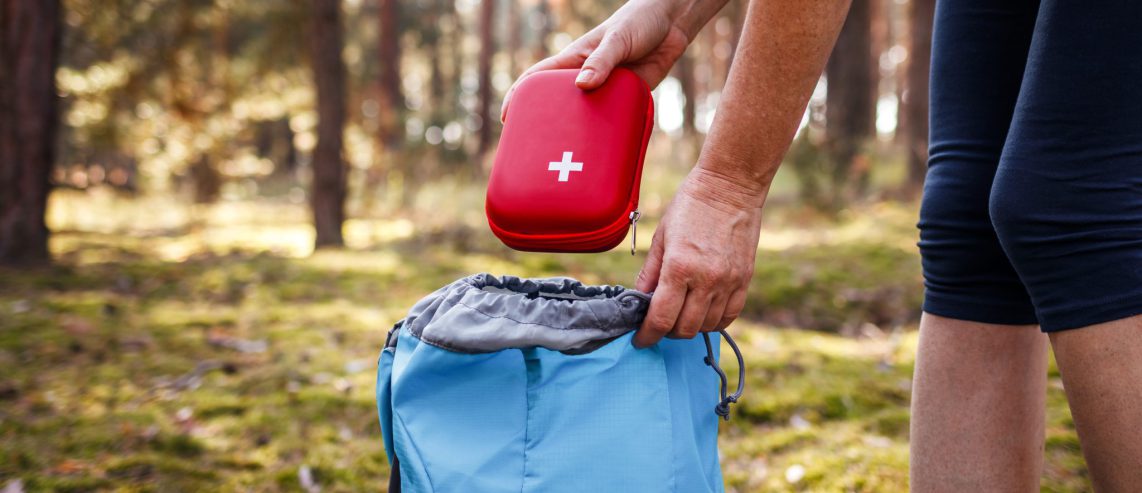When you plan a trip, you may not put much thought into preparing for an emergency. But if you or someone you’re traveling with gets ill or injured, a well-stocked first-aid kit can come in handy.
A travel first-aid kit should include essential items that you may need in a medical emergency. You can buy one from the American Red Cross or another supplier. Or, you can put one together yourself before your trip.
Here are some tips for building your own travel first-aid kit.
Never Miss a Beat!
Subscribe to Our HealthBeat Newsletter!
Thank you for subscribing!
You can now select the specific newsletters you'd like to receive.
You are already subscribed.
Subscribe to more newsletters in our email preference center.
Sorry, an error occurred. Please try again later.
Get Healthy Tips Sent to Your Phone!
Tips to Consider When Building a Travel First-Aid Kit
When building your kit, you should keep a few things in mind:
- Your kit’s size. It should have enough room to include all necessary items but not so much that it’s too big to transport easily. Try a soft-sided bag that can expand or contract depending on how much it contains.
- Your specific medical needs. Do you or someone in your traveling party have a medical condition? Packing extra insulin for someone who has diabetes, an EpiPen for someone with allergies, or an inhaler for someone with asthma may prove necessary. Also, make sure to include medications that you or others you’re traveling with need. Check in with your doctor for more information on packing the right essentials for your condition.
- Your travel destination. Depending on where you’re going, you may need to pack items for that specific location. If you’re going to the beach, bringing extra sunscreen or aloe vera gel for sunburn could help. Or, you may need specific medicines such as antimalarials depending on your destination. Also, you may need to have proof of certain vaccinations. Make sure you take all of those factors into consideration.
- Your trip length. You may need to pack extra if you’re going on an extended trip. If you or someone you’re traveling with has a prescription medicine, make sure they have an adequate amount of it. If you don’t, talk to your doctor about getting a refill before you leave.
Lastly, you should talk to your health insurance provider about travel insurance. Your plan may cover any problems you may encounter during your trip. And make sure to bring your insurance card with you.
What to Put in a Travel First-Aid Kit
Items to include in a travel first aid kit include:
Medicine
- Allergy medications, such as antihistamines and EpiPens, if needed.
- Aloe vera gel for sunburn.
- Anti-itch medicine for bug bites or poison ivy.
- Antimalarial medicines (depending on your destination).
- Diabetes testing supplies and insulin, if needed.
- If packing insulin, be sure to include
a cool pack because insulin needs to stay chilled. - In cases of low blood sugar, have a small can of soda or
juice or an easily dissolvable sugary drink at hand.
- If packing insulin, be sure to include
- Eye drops.
- Inhalers/asthma medication, if needed.
- Pain medications such as aspirin, ibuprofen, or acetaminophen (Tylenol).
- Prescription medications.
- Respiratory medicines such as cough drops, cough suppressants, and nasal decongestants.
- Stomach medications, such as diarrhea medicine, antacids, motion sickness tablets, bismuth subsalicylate (Pepto-Bismol), and laxatives/stool softeners.
- Water purification tablets.
First-aid items
- Ace bandage wrap.
- Antibacterial or antifungal ointments.
- Antibacterial wipes.
- Antiseptic wound cleaner.
- Bandages of various sizes and shapes.
- Gauze.
- Hand sanitizer that contains at least 60% alcohol.
- Hydrocortisone cream.
- Instant cold pack.
- Medical tape.
- Self-adhesive roll-on bandage for larger injuries (such as sprained ankle or knee).
Other items
- Bottled water and snacks that aren’t sensitive to weather.
- Bug repellant (with an active ingredient such as DEET).
- Cotton swabs.
- Digital thermometer.
- Disposable non-latex gloves.
- First-aid blanket.
- Scissors.
- Sunscreen (SPF 30 or higher).
- Tweezers.
Not all of the above items may apply to you or your trip. But you should include most or all of them to ensure safety. The Centers for Disease Control and Prevention (CDC) and American Red Cross have other first-aid kit recommendations to keep in mind.
Wherever you’re going, it’s important to stay safe. Even if you don’t want to imagine having an emergency during a trip, a little preparation can go a long way.
Sources
About UPMC
Headquartered in Pittsburgh, UPMC is a world-renowned health care provider and insurer. We operate 40 hospitals and 800 doctors’ offices and outpatient centers, with locations throughout Pennsylvania, Maryland, New York, West Virginia, and internationally. We employ 4,900 physicians, and we are leaders in clinical care, groundbreaking research, and treatment breakthroughs. U.S. News & World Report consistently ranks UPMC Presbyterian Shadyside as one of the nation’s best hospitals in many specialties and ranks UPMC Children’s Hospital of Pittsburgh on its Honor Roll of America’s Best Children’s Hospitals. We are dedicated to providing Life Changing Medicine to our communities.
